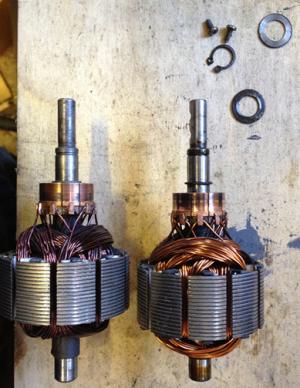


 | |||
|
Cooling
fan motor A V8BB query posted by Nick Gray said "one of my fan motors seized on re-commissioning the car for summer. On taking it to pieces I found the back of the commutator - where the windings attached - had come into contact with the brushes and slowly destroyed them. This appeared to be a design flaw so I took the other motor apart and found all to be fine - the commutator and windings are attached slightly further along the shaft - see alongside. Since there is no way on earth I can supply enough force to slide the windings along the shaft somebody must have replaced the complete armature with a similar but not identical part. I have some replacement brushes but they will only suffer the same fate as the current set unless I can find another armature or a different brush plate (which were identical in each motor). Can anybody shed any light or suggestions on how to solve this?" Victor Smith responded "there are two V8NOTES on the brushes - V8NOTE359 and V8NOTE360 - which you can see via the links on the MGBGTV8 cooling information gateway. Either click the Information Gateway rollover link on the RHS of the V8 website homepage or type in the key words "MGBGTV8 cooling fan motor" in the search box and the links come up. My understanding is the later replacement cooling fan motors had better bearings than the OE motors. I replaced mine some ten or more years ago and they have been reliable. So although I admire your wanting to change the component parts, a clean replacement might well be better in many ways, particularly as they take a great deal of punishment from road muck and windmilling when not running cooling the radiator. I see from the B&G website they have V8 cooling fan motors (part no. ALU1081) at £29.00 plus VAT." Nick Gray responded "it was one of the V8 notes that inspired me to take the fan motor to pieces! I have replaced the fan motor with a new ALU1081 but will still try and fix the old one. The sleeve bearings are perfect and they are far more substantially built than the modern equivalents. They are actually a reasonably clever design with a sealed bearing inside the case at the back - facing the oncoming airflow and a replaceable bearing at the front (fan end) where muck risks getting in. The Lucas motor itself was fitted to many vehicles of the era as windscreen motor, fan heater motor and fan motors. The replacement brushes were only a couple of pounds so I may try and redesign the brush plate (I think a change of design here is the culprit) and see if I can get it working again." Bob Owen added a couple of points related to the fan motors saying "when I was working on cooling problems on my V8 some years ago I had difficulties removing the fans from the motor shafts as the |
 slotted grub screws were damaged and had corroded. When I finally got them off I decided to replace them with socket/Allen headed grub screws - easier to do up and undo. Secondly it's a chance to secure the motors so that the fans are as close as possible to the radiator matrix - I was changing the radiator to one of Clive Wheatley's high performance ones at the time and slotted the rad fixings so I could lift it and have the fan blades clear the header tank allowing a fan to matrix spacing of 1 - 2mm. I also opened up the fan bracket fixing holes to give some fine adjustment. Every little helps. Remember to allow for any motor shaft end float - stationary car and the running fans push themselves away from the radiator, but when travelling along the windmilling blades are being pushed into the radiator." Victor Smith added "there is a useful exploded diagram of the cooling fan motor on page C12 of the MGB Workshop Manual AKD3259 (15th Edition) together with Section C12 on removing and reassembling the motor and Section C13 on fan motor tests. I will scan those pages and post them to the V8 website later today. I also see from my copy of the MGB & V8 Parts Catalogue AKM0039 (February 1977 First Edition) that the V8 cooling fan motor is listed there as BHA5256 on page 108-D7 so I will check with Peter Beadle but I think part number ALU1081 must be the later replacement fan motor." See an illustrated note with an exploded diagram of the fan motor and pages C11 and C12 from the manual. More Posted: 130512 | ||
| | |||

